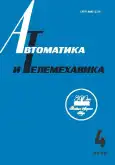Eksperimental'nyy analiz algoritma otsenivaniya gel'derovoy eksponenty na baze kontseptsii ϵ-slozhnosti nepreryvnykh funktsiy
- Autores: Dubnov Y.A1,2, Popkov A.Y.1, Darkhovskiy B.S1
-
Afiliações:
- Federal Research Center “Computer Science and Control,” Russian Academy of Sciences
- National Research University Higher School of Economics
- Edição: Nº 4 (2023)
- Páginas: 19-34
- Seção: Nonlinear systems
- URL: https://journals.rcsi.science/0005-2310/article/view/144270
- DOI: https://doi.org/10.31857/S0005231023040025
- EDN: https://elibrary.ru/CEVIZP
- ID: 144270
Citar
Texto integral
Resumo
This paper describes one method for estimating the Hölder exponent based on the
-complexity of continuous functions, a concept formulated lately. Computational experiments are carried out to estimate the Hölder exponent for smooth and fractal functions and study the trajectories of discrete deterministic and stochastic systems. The results of these experiments are presented and discussed.
Palavras-chave
Sobre autores
Yu. Dubnov
Federal Research Center “Computer Science and Control,” Russian Academy of Sciences; National Research University Higher School of Economics
Email: yury.dubnov@phystech.edu
Moscow, Russia; Moscow, Russia
A. Popkov
Federal Research Center “Computer Science and Control,” Russian Academy of Sciences
Email: apopkov@isa.ru
Moscow, Russia
B. Darkhovskiy
Federal Research Center “Computer Science and Control,” Russian Academy of Sciences
Autor responsável pela correspondência
Email: darbor2004@mail.ru
Moscow, Russia
Bibliografia
- Павлов А.Н., Анищенко В.С. Мультифрактальный анализ сложных сигналов // Успехи физических наук. 2007. Т. 177. С. 859-876.
- Ширяев А.Н. Основы стохастической финансовой математики. 2016. МЦНМО.
- Савицкий А.В. Метод оценки показателя Хёрста фрактального броуновского движения // Доклады РАН. 2019. Т. 489. № 5. С. 456-460.
- Falkoner K.J. Fractal Geometry: Mathematical foundations and Applications. Wiley, 2003.
- Ming L., Vitanyi P. An Introduction to Kolmogorov Complexity and Its Applications (англ.). 2nd ed. Springer, 1997.
- Piryatinska A., Darkhovsky B., Kaplan A. Binary classification of multichannel-EEG records based on the ǫ-complexity of continuous vector functions // Comput. Method. Program. Biomedicin. 2017. V. 152, P. 131-139.
- Piryatinska A., Darkhovsky B. Retrospective change-points detection for multidimensional time series of arbitrary nature: Model-free technology based on the ǫ-complexity theory // Entropy. 2021. V. 23. No. 12. P. 1626.
- Дарховский Б.С. Оценка показателя Гёльдера на основе концепции ǫ-сложности непрерывных функций // Математические заметки. 2022. Т. 111. Вып. 4. С. 620-623.]
- Dahan A., Dubnov Y.A., Popkov A.Y. et al. Brief Report: Classification of Autistic Traits According to Brain Activity Recoded by fNIRS Using ǫ-Complexity Coefficients // J. Autism Dev Disord. 2020. Vol. 51. Iss. 9. P. 3380-3390.
- Дарховский Б.С. О сложности и размерности непрерывных конечномерных отображений // Теория вероятностей и ее применения. 2020. Т. 65. Вып. 3. С. 479-497.
- Колмогоров А.Н. Комбинаторные основания теории информации и исчисления вероятностей // Успехи математических наук. 1983. Т. 38. № 4. С. 27-36.
- Ито К., Маккин Г. Диффузионные процессы и их траектории. М.: Мир, 1968.
- M¨orters P., Peres V. Brownian Motion. Cambridge University Press, 2010.
Arquivos suplementares









